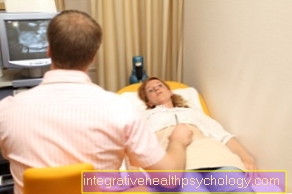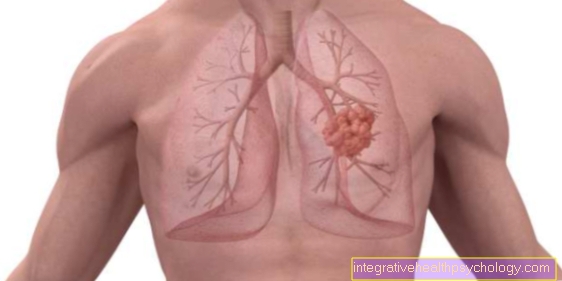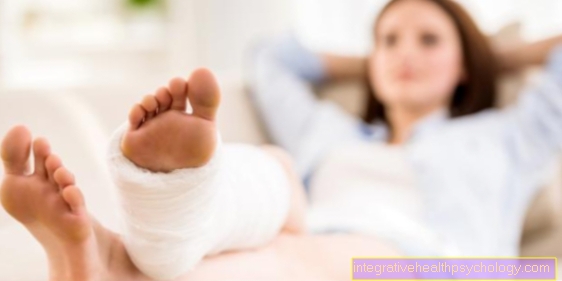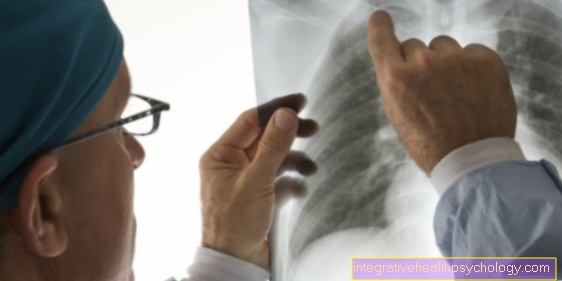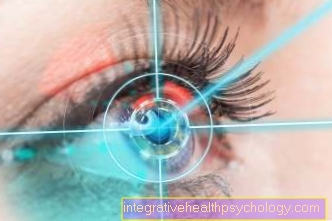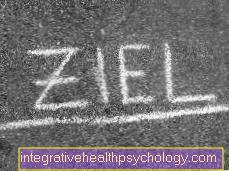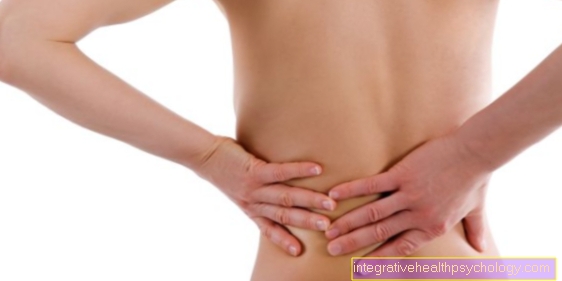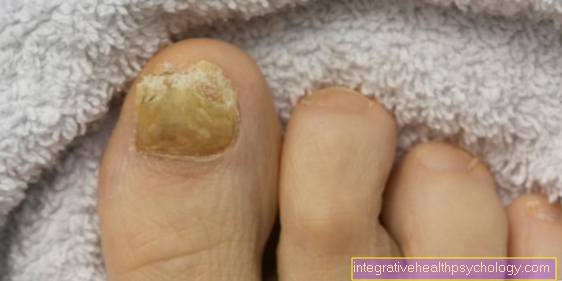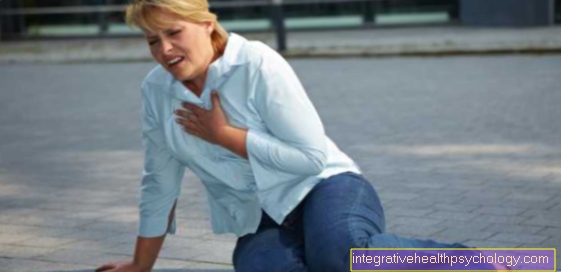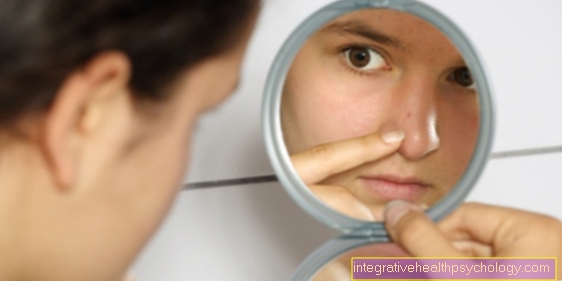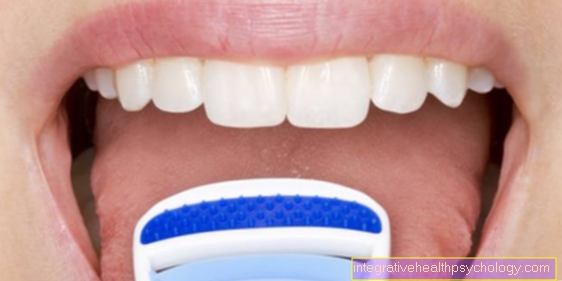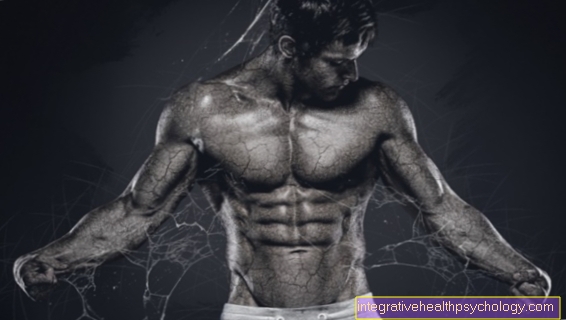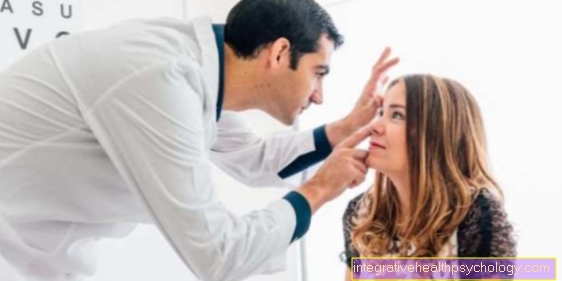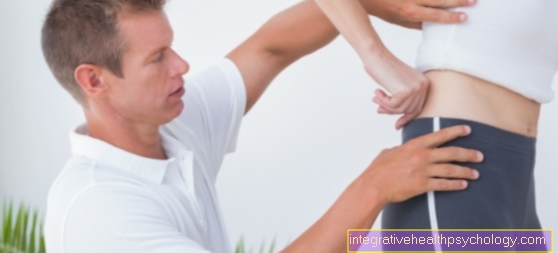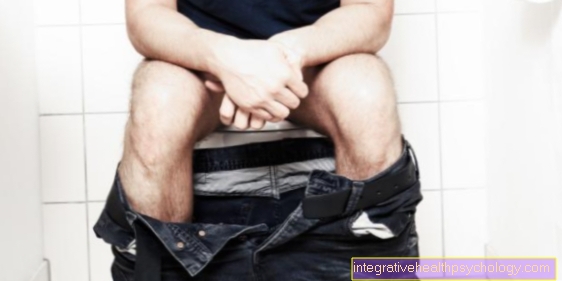Disc herniation at the level of L4 / L5
definition
A herniated disc L4 / 5 is a prolapse (stepping out) of the intervertebral disc between the 4th and 5th vertebrae of the lumbar spine. In this disease of the spine, the inner gelatinous core (nucleus pulposus) slips out of its original position. It is surrounded by a fibrous ring (annulus fibrosus) that can tear as it becomes increasingly worn.
Parts of the inner core and the outer fiber ring can then press on the nerve roots or nerve fibers that run through the adjacent spinal canal. This causes neurological symptoms that can vary depending on the type and severity of the constricted nerve fibers. Prolapse often occurs between L4 and L5 and affects both men and women between the ages of 46 and 55 years.
For more information, see: L4 syndrome you should know that!
Only a herniated disc L5 / S1 occurs more frequently than a herniated disc between L4 and L5.
Read more on the subject at: Herniated disc between L5 and S1

causes
The causes for the development of a herniated disc of the lumbar spine can be very different. One of the main reasons is the increasing wear and tear on the vertebral bodies due to aging. Fibrous ring, gelatinous core and also the surrounding bones become more and more porous and finally give in to the load. The gelatinous nucleus, which stores water and acts as a shock absorber between the vertebral bodies, increasingly loses the function of being able to store water. This creates cracks especially in the rear part of the fiber ring. This results in the inner core slipping quickly in the event of unfortunate jerky movements or heavy lifting.
Another cause can be a permanent incorrect load on the spine. A crooked posture at the desk or workplace leads to an uneven distribution of the load and can cause a herniated disc in the lumbar spine. It is similar when you stand for a long time. The load is greatest in the lumbar spine. In addition, factors such as age and obesity play an important role in the development of a herniated disc.
Weak back and abdominal muscles do not stabilize the spine sufficiently, so that a herniated disc is more likely to occur because the wear and tear due to the overload is greater.
Furthermore, certain sports that put a lot of strain on the back can also contribute to the development of a herniated disc. Injuries due to accidents are less common causes.
Read more about this topic on the page:
- L4 syndrome you should know that!
- L5 syndrome
- Causes of a herniated disc
Appointment with a specialist for a herniated disc?

I would be happy to advise you!
Who am I?
My name is I am a specialist in orthopedics and the founder of .
Various television programs and print media report regularly about my work. On HR television you can see me every 6 weeks live on "Hallo Hessen".
But now enough is indicated ;-)
A herniated disc is difficult to treat. On the one hand it is exposed to high mechanical loads, on the other hand it has great mobility.
Therefore, treating a herniated disc requires a lot of experience.
The aim of any treatment is treatment without surgery.
Which therapy achieves the best results in the long term can only be determined after looking at all of the information (Examination, X-ray, ultrasound, MRI, etc.) be assessed.
You can find me in:
- - your orthopedic surgeon
14
Directly to the online appointment arrangement
Unfortunately, it is currently only possible to make an appointment with private health insurers. I hope for your understanding!
Further information about myself can be found at
Symptoms
Symptoms usually depend on the height and extent of the herniated disc. If a prolapse occurs at level L4 / 5, the nerve bundles and nerve roots located there can be damaged. The subsequent symptoms depend on the extent to which the nerves are narrowed and injured (see also: Herniated disc with nerve damage). The nerve fibers emerging from the spinal cord at level L4 / 5 are responsible for certain movements on the leg as well as for the sensitive innervation of limited areas of the skin.
Correspondingly, injuries can lead to sensitivity disorders on the outside of the thigh, on the kneecap and on the inside of the lower leg. The patient may no longer feel a touch on these areas of the skin. You may also feel numb and tingling. Many patients describe these symptoms as pins and needles, tingling, or numbness.
L4 damage
If the nerve tracts are more severely impaired, various symptoms of muscle failure can occur. The nerve fibers from L4 are also responsible for the innervation of the thigh muscles. The nerve damage may result in the patient no longer being able to straighten the knee. At the same time, it can also be difficult to lift the foot.
For more information, see: L4 syndrome you should know that!
L5 damage
Damage to the nerves that emerge from the L5 segment can lead to impaired sensitivity on the inside of the thigh, the back of the foot and the big toes.
The disorder can manifest itself here as numbness or tingling.
If this segment is severely damaged, the toe lifter may lose its functionality. In addition to the neurological deficits mentioned, the pain is typical of a herniated disc. The pain occurs at the level of the damaged nerves. This type of pain is also known in medical jargon as radical pain. The character of the pain is dull and suddenly shooting in, stabbing pain. In the case of a herniated disc at level L4 / 5, the pain can radiate particularly into the leg or even further into the foot.
The severity of the pain often correlates with the severity of the damage to the nerves. The back pain that arises is also known as low back pain. Under stress and certain movements, such as sneezing and coughing, the patients report a worsening of the symptoms, which is why they often adopt a relieving posture, which also contributes to the spine being incorrectly stressed.
In severe cases of a herniated disc, even vegetative functions such as emptying the bladder and bowel can be disturbed. The patient then no longer has a controlled discharge of urine and stool. This often represents an enormous psychological burden for those affected.
The herniated disc in the lumbar spine can also trigger a so-called cauda equina syndrome, which should be recognized urgently and, if left untreated, can lead to permanent paraplegia. We therefore recommend our website for further information: Cauda equina syndrome - do I have paraplegia?
Read more on the topic: Symptoms of a herniated disc in the lumbar spine
Numbness (dermatome)
A lumbar disc herniation can have various symptoms as well Numbness occur. This is a numbness of various areas of the skin that are sensitively supplied by the damaged nerves. The complaints can vary individually. Tingling, pins and needles or even complete numbness can occur. The complaints are also dependent on the strength of the Nerve damage. Depending on the level of nerve damage, the sensory disturbances occur in certain skin areas. The supply areas of the nerves that emerge from the vertebral bodies L4 / 5 are each responsible for a certain skin area on the leg. These delimited areas are called Dermatome designated. They give an important indication of the extent of the damage as part of the diagnosis. In this way, the doctor can draw conclusions about the damaged nerve on the basis of numbness at a certain skin area.
Identification muscles L4 and L5
In anatomy and also in neurology one understands by Identification muscles specific muscles that are innervated by a single segment of the spine. At the same level as the segment, there is a for left and right Spinal ganglion, from which nerve fibers emerge that supply certain muscles. These key muscles are particularly important when diagnosing various diseases of the spine. If these key muscles fail to function, the doctor can use certain tests to obtain an initial indication of the level of the Spine the injury could be. The symptoms range from muscle weakness to a loss of function of the muscle.
The extent depends on the severity of the nerve damage. Furthermore, certain Reflexes weakened or no longer resolvable. The key muscle for segment L4 is the large thigh muscle (Quadriceps femoris muscle). It enables diffraction in the hip joint and the stretching in Knee joint. If the responsible nerve is restricted due to a prolapse, failure symptoms can occur. Furthermore, the function of the nerve with the Patellar tendon reflex getting tested. To do this, the doctor taps lightly below the with a reflex hammer Kneecap (Patella) on the firm tendon of the muscle running there. Normally the leg would snap forward. If there is damage to the nerve, the reflex may be weakened or even not manifest at all.
The key muscle for lumbar segment 5 is the extensor of the big toe (Extensor hallucis longus muscle).If this segment is damaged, depending on the severity of the injury, the patient is no longer able to consciously stretch the big toe. The doctor can also test the function of this nerve tract with the Tibialis posterior reflex (TPR). The doctor taps the corresponding tendon of the muscle on the inside of the foot below the protruding ankle with a special reflex hammer. On the one hand, an internal rotation (supination) of the foot and also the extension of the big toe can be seen on the one hand. If there is pronounced damage to the nerve tract and thus to the characteristic muscle, this reflex cannot be triggered.
Symptoms to the right or left
Most Herniated discs occur in the lumbar spine area and affect segments L4 / L5. Since such a prolapse is the slipping of the intervertebral disc, it can move in different directions. It can slide up or down and to the right or left. In the case of a left or right shift, one speaks of a medio-lateral disc herniation. This often leads to various symptoms.
The nerve roots emerge from the nerve root on the left and right from a segment of the spine Spinal nerves out. They take over the innervation of muscles or else internal organs. If the intervertebral disc slips sideways (laterally), these nerve roots are compressed and the nerves are constricted. The longer this pressure is on the nerves, the stronger the symptoms. Often it comes to one side on the one hand Back pain and also to pain in the corresponding leg.
The examinations on the leg can then provide information about the height of the injured segment. Imaging can then reveal the full extent of the injury.
In the pictures you can also see to which side (right, middle, left) the Intervertebral disc has moved.
Diagnosis of a herniated disc in the lumbar spine

The diagnosis of a herniated disc L4 / 5 can be made very well as part of a neurological examination.
In addition to a detailed anamnesis of the complaints and especially the pain, the doctor can quickly obtain information about existing nerve damage with the help of various tests. Using a reflex hammer, he tests the reflexes on arms and legs, the sensitivity of different skin areas and also the mobility of different muscles.
In addition, the nerve conduction speed can also be determined by a measurement. It provides information on the function of the nerves. Depending on how well the reflexes can be resolved or where the pain is radiating, the doctor can draw conclusions as to which nerve roots may be damaged. The posture and the course of the spine are also examined.
Read more on the topic: Bragard test
The diagnosis of a herniated disc is usually confirmed by a radiological examination. The means of choice are imaging methods such as computed tomography (CT) and magnetic resonance tomography (MRI of the lumbar spine).
With MRI of the lumbar spine and with CT, the spine is represented graphically. In an MRI of the lumbar spine, the surrounding soft tissue structures such as the intervertebral disc can also be shown very well. In the case of a prolapse, the x-ray itself may show fine cracks in the intervertebral disc.
In addition, the L4 / 5 herniated disc itself can also be recognized very well if a picture is taken from the side of the spine.
The intervertebral disc of the lumbar spine has then advanced into the spinal canal and the posterior surfaces of the surrounding vertebral bodies are also closer to one another.
The cartilage surfaces of the vertebral bodies can be porous due to wear and tear and incorrect loading. The procedures (CT / MRT of the lumbar spine) can also be supported by the administration of contrast medium, which is injected into the vein. The structures can then be seen even more clearly.
MRI of the lumbar spine

Image of an MRI of the lumbar spine:
Green: vertebral bodies
Red: herniated disc L4 / 5
Blue: facet joints L4 / 5
Purple: spinous process
Therapy of a herniated disc L4 / 5
Conservative therapy
In most cases, a disc prolapse Treated conservatively. As a rule, the period of rest is limited to about six to eight weeks. This varies greatly depending on the type and severity of the disc injury. This means that there is no surgical intervention.
As part of conservative therapy, the first thing to do is to protect the Spine and relieving pain are paramount. In acute cases, the patient should therefore not put any strain on the spine. With a lot of rest and care they can inflammatory processes First heal on the intervertebral discs.
Furthermore, conservative therapy includes a drug pain therapy for a herniated disc. In the form of tablets or direct local injections, drugs can be given to relieve pain. Injections into the injured spine area can be uncomfortable but have quick, pain relieving effects. Medicines are also often given to relax the muscles so that the patient can relieve the symptoms no relieving posture which often makes the symptoms worse. Also have a muscle relaxing effect warmth and expert light Massages. Also relaxing Electrotherapy is often used. Regular physiotherapy to strengthen the muscles is also useful.
Much more extensive information on this topic can be found at: Therapy of a herniated disc of the lumbar spine
surgery
A surgery becomes particularly necessary when the symptoms are very advanced and too pronounced Signs of paralysis comes. The duration of the herniated disc also plays a decisive role. The longer a nerve is constricted, the lower the likelihood that it will recover and continue to function.
Surgery is recommended to the patient even if conservative therapy is unsuccessful. More and more often the operation takes place than minimally invasive intervention instead of. Accordingly, only a small incision is necessary and the operation itself is carried out through a microscope and with appropriately small instruments. The aim of the surgery is to keep the slipped Intervertebral disc from the Spinal canal to remove. This relieves the stress on the constricted nerves and allows them to recover. The intervertebral disc can possibly be replaced by appropriate materials so that between the Vertebral bodies a Shock absorbers as well as protection of bone persists. An operation usually takes between 30 and 60 minutes. After the operation, the patient can sit straight upright. It may be necessary to wear a light bodice. Then the whirl and also the patient can recover better from the complaints. If there are multiple herniated discs, an area of the spine can also be completely stiffened.
Exercises / physiotherapy for a herniated disc in the lumbar spine
Regular Physiotherapy for a herniated disc is of great importance in the treatment of herniated discs. Its aim is to rebuild and strengthen the back and abdominal muscles. This should promote the stability of the spine. Physiotherapy also includes Massagesthat can loosen the muscles, prevent bad posture and at the same time relieve pain. As part of the therapy, the patient also learns exercises that he can do independently at home. This includes, for example, stretching exercises with the help of straps or an exercise ball. Sitting upright on a large ball and gently circling your hips relaxes the muscles in the lumbar region. At the same time, ligaments are loosened and strengthened. Exercises carried out under water are very sparing for the back. For this purpose, courses in the form of Aqua aerobics usually also offered specifically for back problems.
The patient learns exercises and also those in the back school correct posture when standing or sitting for a long time to relieve his back. The exercises are designed to strengthen the back muscles and promote movement. It is important to ensure that all exercises are performed painlessly and are sufficiently repeated. Relaxation exercises can be very good in everyday life and can also be done in between. They prevent relieving postures and tension.
You can also read more on this topic at: Exercises after a herniated disc of the lumbar spine
Sport after a herniated disc L4 / 5
Not every sport can be performed again immediately after a herniated disc. The back must first be spared and relieved. Otherwise, the symptoms can worsen again very quickly, or further disc injuries can occur. Exercise should be preferred, which stress and strengthen the back and abdominal muscles equally.
Jerky movements and jolts should also be avoided. Sports like swim, hike, Nordic walking, Pilates and Cross-country skiing. Sports that put extreme stress on the back should be avoided due to the risk of injury. Compression movements and twisting movements can also be harmful to a previously damaged back. So the patient should be on tennis, do gymnastics, squash, badminton and also To ski initially be waived.
Furthermore, the muscles should be strengthened with light exercises. Bodybuilding and weightlifting place too much strain on the spine and further damage the intervertebral discs and should only be taken up after they have healed completely.

